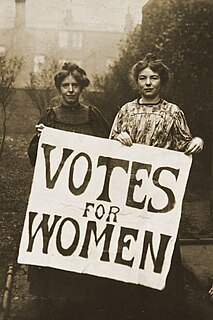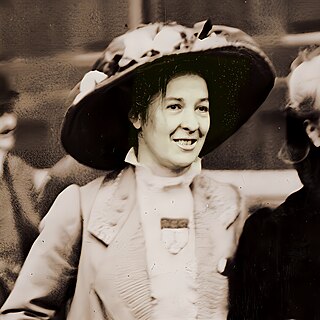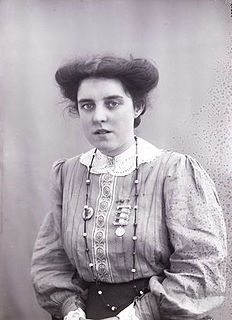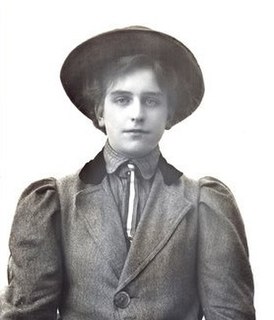
Estelle Sylvia Pankhurst was an English campaigner for the suffrage and suffragette movement, a socialist and later a prominent left communist and activist in the cause of anti-fascism and the international auxiliary language movement. She spent much of her later life campaigning on behalf of Ethiopia, where she eventually settled.

The Women's Social and Political Union (WSPU) was a women-only political movement and leading militant organisation campaigning for women's suffrage in the United Kingdom from 1903 to 1918. Known from 1906 as the suffragettes, its membership and policies were tightly controlled by Emmeline Pankhurst and her daughters Christabel and Sylvia.

The Women's Freedom League was an organisation in the United Kingdom which campaigned for women's suffrage and sexual equality. It was an offshoot of the militant suffragettes after the Pankhursts decide to rule without democratic support from their members.

Teresa Billington-Greig was a British suffragette who helped create the Women's Freedom League in 1907. She had left another suffrage organisation – the Women's Social and Political Union (WSPU) – as she considered the leadership too autocratic. In 1904, she was appointed by the WSPU as a travelling speaker for the organisation. On 25 April 1906, she unveiled a 'Votes for Women' banner from the Ladies Gallery during the debate in the House of Commons. In June 1906, she was arrested in a fracas outside of Chancellor of the Exchequer H. H. Asquith's home, and as a result was the first suffragette to be incarcerated in Holloway Prison.

Edith How-Martyn was a British suffragette and a member of the Women's Social and Political Union (WSPU). She was arrested in 1906 for attempting to make a speech in the House of Commons. This was one of the first acts of suffragette militancy. She met Margaret Sanger in 1915 and they created a conference in Geneva. How-Martyn toured India talking about birth control. She had no children and died in Australia.

Charlotte Despard was an Anglo-Irish suffragist, socialist, pacifist, Sinn Féin activist, and novelist. She was a founding member of the Women's Freedom League, Women's Peace Crusade, and the Irish Women's Franchise League, and an activist in a wide range of political organizations over the course of her life, including among others the Women's Social and Political Union, Humanitarian League, Labour Party, Cumann na mBan, and the Communist Party of Great Britain.

Anna Gillies Macdonald Munro was an active campaigner for temperance and the women's suffrage movement in the United Kingdom. Munro organised and was the secretary of the Women's Freedom League campaigning in Scotland. She settled in Thatcham after the First World War but was living in Aldermaston by 1933 and died in Padworth, Berkshire in 1962. She had affordable housing named after her in Thatcham.

Theresa Garnett was a British suffragette. She was a serial protester who sometimes went by the name 'Annie O'Sullivan', was jailed and then still refused to cooperate. She assaulted Winston Churchill while carrying a whip. She retired from her militancy after the suffragette movement decided to commit arson as part of its protests. She was honorary editor of a women's right's magazine in 1960.

The Women's Peace Crusade was a grassroots socialist movement that spread across Great Britain between 1916 and 1918. Its central aim was to spread a 'people's peace', which was defined as a negotiated end to the First World War without any annexations or indemnities. The movement was first established in Glasgow in July 1916, and officially launched on 10 June 1917. It later spread across Great Britain, with demonstrations taking place in Leeds, Bradford, Leicester, Birmingham and Lancashire. Although it gathered a substantial following, the Women's Peace Crusade faced opposition from both the government and police, with members being arrested and reportedly threatened.

Mary Elizabeth Phillips was a suffragette, feminist and socialist. She was the longest prison serving suffragette. She worked for Christabel Pankhurst but was sacked; she then worked for Sylvia Pankhurst under name Mary Pederson. In later life she supported women's and children's organisations.

Vera Wentworth was a British suffragette. She went to jail for the cause and was force fed. She door stepped and then assaulted the Prime Minister twice. She wrote "Three Months in Holloway"

Alice Schofield or Alice Schofield Coates was a British suffragette and politician. She campaigned for women to have the vote and later campaigned for the legislation to give women rights to equal pay.

Janet "Jenny" McCallum or Janet Richardson was a United Kingdom trade unionist and suffragette.

Emma Sproson, was a suffragette, then a suffragist, socialist, politician and women's rights activist. Active in the Midlands and from a working class background, she became Wolverhampton's first female councillor, gaining the nickname "Red Emma" in the process.

Lucy Minnie Baldock was a British suffragette. Along with Annie Kenney, she co-founded the first branch in London of the Women's Social and Political Union.

Annot Robinson, nicknamed Annie, was a Scottish suffragette and pacifist. She was sentenced to six months for trying to break in to the House of Commons. She helped to found the Women’s International League for Peace and Freedom.

Grace Roe (1885–1979) was Head of Suffragette operations for the Women's Social and Political Union. She was released from prison after the outbreak of World War I due to an amnesty for suffragettes negotiated with the government by the WSPU.

Kate Williams Evans was a Welsh suffragette, activist and campaigner for women's rights. She was imprisoned in Holloway Prison where she went on hunger strike for which she received the WSPUs Hunger Strike Medal which was sold to National Museum Wales for £48,640 in 2018.

Sarah Barbara Benett was a suffragette, a member of the Women's Social and Political Union (WSPU) and Treasurer of the Women's Freedom League (WFL). She was one of the "Brown Women" who walked from Edinburgh to London in 1912 and went on hunger strike during her imprisonment in Holloway Prison for which she received the WSPU's Hunger Strike Medal and Holloway brooch.
Florence Earengey was a British suffragette and a member of the Women's Freedom League.


















